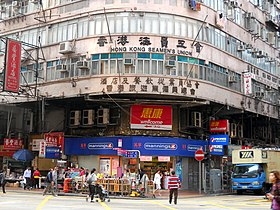Composite building

Composite buildings are a common feature of the architectural style of Hong Kong buildings that were constructed in the 1950s and the 1960s.
History[edit]

The term "composite building" came from the Building Ordinance and refers to residential buildings with workplaces and workshops.[citation needed]
Composite buildings are abundant in Hong Kong because:
- The People's Republic of China was founded in 1949, when Hong Kong was a capitalist state, which provided capitalists with opportunities to develop industries.
- In the early 1950s, China was under trading sanctions, which made it possible for Britain to transform Hong Kong into a hub for exports and manufacturing.[1]
- Composite buildings met demands for housing and increased employment during a population boom.[2]
Standards[edit]

- Building Ordinance states a composite building must have a part for residential and a part for other uses.
- Buildings with ten or more storeys or more must have a lift installed, limiting height to save costs.[3]
- Due to aircraft departing from or landing at Kai Tak Airport, buildings in Kowloon have height restrictions.[4]
Architecture[edit]

Corner buildings typically have rounded corners. Rounded buildings have cantilevered terraces on all floors above ground floor. Store names on signs hanging from the lower and upper floors can be seen in the building. The architecture combines modern, international, and Bauhaus styles.
Gallery[edit]
-
Cantilevered terrace on the ground of a block.
-
A building with sealed terraces.
-
The architecture fuses with modern elements.
-
An inscription found on a building's entrance.
Today[edit]
in Hong Kong, manufacturing has been on the decline so remaining spaces have been converted into hotels, hospitals, beauty salons, parlours, clubs, and fitness centres.
Many of the buildings built in the twentieth century are subject to acquisition by developers; they are demolished and then replaced with taller, high-rise buildings like the ones on Berwick Street, Shek Kip Mei. However, some of them are being restored to slow down their aging, increase their safety, and improve their appearance.
In popular culture[edit]
Many movies take place in a setting with buildings such as these. Neon signs are often used to make it look like the movie takes place in a high-density city. These buildings were featured in scenes from the following movies: Blade Runner, Ghost in the Shell, Deus Ex, Shenmue II, Sleeping Dogs and Case Files. They are also sometimes featured in cyberpunk music.
Gallery[edit]
-
Metropole Building, North Point[6]
Example[edit]
This section needs additional citations for verification. (March 2022) |


Metropole Building (Chinese: 新都城大廈) is a composite building in Hong Kong. The Metropole Building used to be a site called Ming Yuen Amusement Park. There are four buildings inside this complex. It was designed by Szeto Wai. The complex is located at 416–438 King's Road, North Point, Hong Kong Island.
The first phase of Metropole Building (Blocks A and B) was built in 1967. The second phase was built in October 1972. The complex is split into four blocks, each with 25 storeys. Blocks B and C are connected with corridors, which are found in the public housing estates. The complex has 1,037 units.
The ground floor to the third floor is home to Metropole Mall, a large, old, shopping place that houses Fu Lum Group, Saizeriya store, Café de Coral shop, Wellcome store, a Jusco shop, Fortress shop, Bossini store, G2000 store and Hung Fook Tong store.
In 2010, Metropole Building underwent a significant renovation. lifts were replaced, and lobbies, corridors, pipes and other facilities were modernized.
During the 1967 Hong Kong riots, the Metropole Building and Kiu Kwan Mansion became a target for leftist rioters. Royal Hong Kong Police and the UK Army searched these buildings for suspected leftist rioters.[7]
See also[edit]
References[edit]
- ^ 卡夫卡 (23 December 2010). "何謂街角樓?" (in Chinese). 信報. Archived from the original on 20 August 2018. Retrieved 19 August 2018.
- ^ 黃碧珊 (14 April 2015). "轉角有間老賓館" (in Chinese). 蘋果日報. Archived from the original on 24 August 2018. Retrieved 24 August 2018.
- ^ Tom Grundy (28 June 2012). "PHOTOGRAPHY – Michael Wolf's Hong Kong Cornerhouses". Hong Wrong. Archived from the original on 5 August 2018. Retrieved 20 August 2018.
- ^ a b Janice Seow (29 June 2016). "A Piece of Hong Kong's History: Composite Buildings". Indesignlive.hk. Archived from the original on 20 August 2018. Retrieved 20 August 2018.
- ^ Hana Davis (15 June 2019). "How Hong Kong's historic tong lau and composite buildings shaped the city's built environment". South China Morning Post. Archived from the original on 8 November 2020. Retrieved 9 October 2020.
- ^ Seng, Eunice Mei Feng (2020). Resistant City: Histories, Maps and the Architecture of Development. Singapore: World Scientific. p. 120. ISBN 9789811211706.
- ^ "工商日報社論 1967年8月5日" (in Chinese). 5 August 2012. Archived from the original on 10 September 2014. Retrieved 7 October 2012.[unreliable source?]
Further reading[edit]
- Michael, Wolf (2010). Hong Kong corner houses. Hong Kong University Press. ISBN 978-988-8028-72-6. Archived from the original on 24 July 2021. Retrieved 19 December 2021.






![Chungking Mansions, Tsim Sha Tsui[5]](http://upload.wikimedia.org/wikipedia/commons/thumb/b/bf/Chung_king_mansions_2012.jpg/280px-Chung_king_mansions_2012.jpg)
![Metropole Building, North Point[6]](http://upload.wikimedia.org/wikipedia/commons/thumb/b/bb/HK_North_Point_King_s_Road_Metropole_Building.JPG/280px-HK_North_Point_King_s_Road_Metropole_Building.JPG)
![May Wah Building, Wan Chai[4]](http://upload.wikimedia.org/wikipedia/commons/thumb/3/3f/Wan_Chai%2C_Hong_Kong_-_panoramio_%2817%29.jpg/280px-Wan_Chai%2C_Hong_Kong_-_panoramio_%2817%29.jpg)